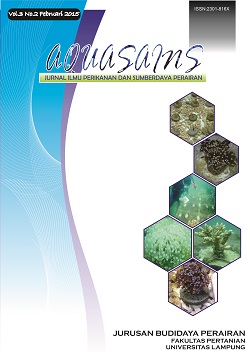Hubungan Perubahan Kualitas Air Dan Pertumbuhan Fitoplankton Berbahaya Pada Lingkungan Budidaya Ikan Di Perairan Ringgung Teluk Lampung
Abstract
Water quality becomes the critical factor of successfully aqua culture process; especially this is in aquaculture of floating cages. Otherwise, unstable water quality could impact the negative effect toward aquatic ecosystem such as the large explosion of harmful phytoplankton population (HABs). The objective of this research is to analyze a relation between the water quality of floating cages and the growth of harmful phytoplankton population by using canocial corelation analysis. Water quality research includes its brightness, the deepness, disolved oxygen, salinity, pH, value of NO2, NO3, NH3, and PO4 and toxic phytoplankton obtained during the study also indicate the amount of phytoplankton growth The results were obtained 14 species of toxic phytoplankton in the study sites. Overall abundance of phytoplankton dominated by Choclodinium, Trichodesmium Erythraeum, Nitzschia Lanceolata dan Pseudo Nitzschia, where Choclodinium an abundance of phytoplankton with the highest density of 63 739 cells/l. Canonical correlation analysis on triplot diagram showed water quality includes : brightness, disolved oxygen, pH, NO2, NO3 and PO4 together to give effect to toxic phytoplankton abundance. Canonical correlation analysis also specifically indicate the abundance Choclodinium and Trichodesmium Erythraeum in floating nets of Ringgung Marines predominantly influenced by brightness, pH, value of NO3, and PO4.Downloads
Download data is not yet available.
Downloads
Published
2015-02-03
How to Cite
Solihin, A., Hasani, Q., & Yulianto, H. (2015). Hubungan Perubahan Kualitas Air Dan Pertumbuhan Fitoplankton Berbahaya Pada Lingkungan Budidaya Ikan Di Perairan Ringgung Teluk Lampung. AQUASAINS, 3(2), 289–296. Retrieved from https://jurnal.fp.unila.ac.id/index.php/JPBP/article/view/725
Issue
Section
Articles
License
License for Authors
Authors who publish with this journal agree to the following terms:
- Authors retain copyright and grant the journal right of first publication with the work simultaneously licensed under a Creative Commons Attribution License that allows others to share the work with an acknowledgement of the work's authorship and initial publication in this journal.
- Authors are able to enter into separate, additional contractual arrangements for the non-exclusive distribution of the journal's published version of the work (e.g., post it to an institutional repository or publish it in a book), with an acknowledgement of its initial publication in this journal.
- When the article is accepted for publication, its copyright is transferred to Aquasains Journal. The copyright transfer convers the exclusive right to reproduce and distribute the article, including offprint, translation, photographic reproduction, microfilm, electronic material, (offline or online) or any other reproduction of similar nature.
- Authors are permitted and encouraged to post their work online (e.g., in institutional repositories or on their website) prior to and during the submission process, as it can lead to productive exchanges, as well as earlier and greater citation of published work (See The Effect of Open Access).
- The Author warrant that this article is original and that the author has full power to publish. The author sign for and accepts responsibility for releasing this material on behalf os any and all-author. If the article based on or part os student’s thesis, the student needs to sign as his/her agreement that his/her works is going published.
License for Regular Users
Other regular users who want to cite, distribute, remix, tweak, and build upon author’s works, even for commercial purposes, should acknowledge the work’s authorship and initial publication in this journal, licensed under a Creative Commons Attribution License.
This license lets others distribute, remix, tweak, and build upon your work, even commercially, as long as they credit you for the original creation.
This work is licensed under a Creative Commons Attribution 4.0 International License.Copyright Transfer Statement can be downloaded here


.png)









